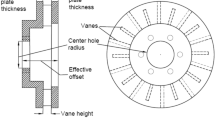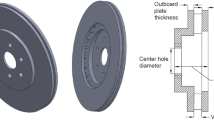Abstract
In order to alleviate the problem of the temperature rise, thermal deformation and unreasonable local distribution of equivalent stress which will cause fatigue damage and reduction of the service life of the disc brake. In this study, the friction-thermal-mechanical multi-dimensional coupling analysis of the disc brake of belt conveyor is carried out, and the distribution of the transient temperature field and stress field of the disc brake under the emergency braking condition is obtained. The structural parameters of brake disc and brake shoe are taken as design variables, and the maximum temperature and maximum equivalent stress of the brake disc are taken as the optimization objectives. The Kriging response surface proxy model of the maximum temperature and maximum equivalent stress of the brake disc is constructed by using the optimal space filling to collect the data sample points. According to this, the multi-objective genetic algorithm (MOGA) is used to optimize the design, and the optimized structural parameters are obtained, such as thickness and diameter of the brake disc, thickness, length and width of the brake shoe. The maximum temperature, maximum equivalent stress and maximum deformation are reduced, and the fatigue life cycle is improved, which provides a theoretical basis and reference basis for the improvement of relevant technologies of the disc brakes.
Access this chapter
Tax calculation will be finalised at checkout
Purchases are for personal use only
Similar content being viewed by others
References
Jia Y, Dai Y (2014) Design of disc brake for mine hoist. Mach Tools Hydraulics 42(10):57–58+71
Hou Y, Xie F, Huang F (2011) Control strategy of disc braking systems for downward belt conveyors. Min Sci Technol (China) 21(4):491–494
Barber JR (1969) Thermoelastic instabilities in the sliding of conforming solids. Proc R Soc Lond 312(1510):381–394
Akshit C, Aryan J, Akshay K, Mohammad Z (2022) Coupled thermal and structural analysis of disc brake rotor with varying angle of rotation of ventilation holes. Mater Today Proc 56(2):834–844
Jaiswal R, Jha AR (2016) Structural and thermal analysis of disc brake using solidwork and ANSYS. Int J Mech Eng Technol 7(1):67–77
Sun D, Liu S, Hao Y (2019) Thermal reliability analysis of in-wheel wet brake assembly under high-intensity braking with multi-field coupling. Autom Eng 41(2):161–169
Rahim J, Recep A (2022) Optimization and thermal analysis of radial ventilated brake disc to enhance the cooling performance. Case Stud Thermal Eng 30(10):173–186
Hui L, Yu D (2016) Optimization design of a disc brake system with hybrid uncertainties. Adv Eng Softw 98:112–122
Kumar N, Singh A, Singh S, Singh JIP, Kumar S (2021) Napier natural fibre used as reinforcement polymer composite: as asbestos free brake friction material. Mater Today Proc 56:2532–2536. Part 5, ISSN 2214-7853
Wang N, Yu Z, Zong C (2020) Simulation analysis and experiment study on instantaneous temperature field of disc brake for mine belt conveyor. Coal Min Mach 41(5):74–76
Mcphee AD, Johnson DA (2008) Experimental heat transfer and flow analysis of a vented brake rotor. Int J Therm Sci 47(4):458–467
Young J, Ikjin L, Sung JK (2017) Topology optimization of heat sinks in natural convection considering the effect of shape-dependent heat transfer coefficient. Int J Heat Mass Transf 109:123–133
Liu Z, Li M, Zhang G (2013) Simulation and analysis on temperature field of disk brake for large belt conveyors in collieries. Min Mach 41(08):64–67
Han W (2019) Analysis on temperature distribution of disc brake in mine transportation system based on finite element method. Mech Res Appl 32(01):68–70+73
Li W, Yue W, Huang T, Ji N (2021) Optimizing the aerodynamic noise of an automobile claw pole alternator using a numerical method. Appl Acoust 171:45–56
Wu J (2020) A new sequential space-filling sampling strategy for elementary effects-based screening method. Appl Math Model 83:419–437
Lu H, Yu D, Xie Z, Lu H (2013) Optimization of vehicle disc brakes stability based on response surface method. J Mech Eng 49(09):55–60
Wang G, Shan S (2007) Review of metamodeling techniques in support of engineering design optimization. J Mech Des 129(4):415–426
Arthur K, Julien M, Michel K (2015) Global extremum seeking by Kriging with a multi-agent system. IFAC-Papers 48(28):526–531
Simpson TW, Mauery TM, Korte JJ (2001) Kriging models for global approximation in simulation-based multidisciplinary design optimization. AIAA J 39:2233–2241
Falsone G, Impollonia N (2004) About the accuracy of a novel response surface method for the analysis of finite element modeled uncertain structures. Probab Eng Mech 19(1):53–63
Duddeck F (2008) Multidisciplinary optimization of car bodies. Struct Multi Optim 35(4):375–389
Wang Y, Chen W, Xie Y, Deng S (2017) Application of multi-objective genetic algorithm to body-in-white dynamic performance optimization. Autom Eng 39(11):1298–1304
Deb K, Pratap A, Agarwal S (2002) A fast and elitist multi-objective genetic algorithm: NSGA-II. IEEE Trans Evol Comput 6(2):182–197
Yang J, Zhang D (2019) Multi-objective optimization of container based on genetic algorithm. Veh Power Technol 04:1–36
Acknowledgements
Supported by National Natural Science Foundation of China (Grant No. 52105041), Open Foundation of the State Key Laboratory of Fluid Power and Mechatronic Systems (Grant No. GZKF-202018), and Key Projects of Natural Science Research in Anhui Universities (Grant No. KJ2020A0258).
Author information
Authors and Affiliations
Corresponding author
Editor information
Editors and Affiliations
Appendix
Appendix
- Thermal conductivity of air:
-
ka = 0.0276 W/m K
- Outer diameter of brake disc:
-
d0 = 0.8 m
- Density of air:
-
pa = 1.13 kg/m3
- Dynamic viscosity of air:
-
μa = 1.91 × 10−5 N s/m2
- Material thermal conductivity:
-
λ (W/m K)
- Material density:
-
ρ (kg/m3)
- Material specific heat capacity:
-
c (J/(kg K))
- Friction coefficient between brake disc and brake shoe:
-
μ
- Angular speed of brake disc rotation:
-
w (rad/s)
- Contact pressure:
-
p (kN)
- Approximate values obtained from response surface model:
-
\(\hat{y}_{i}\)
- Real value obtained by finite element analysis:
-
y i
- Average of true values:
-
\(\overline{y}\)
- Design variables of disc brake:
-
x = (x1, x2, x3, x4, x5)
- Upper and lower limits of design variables:
-
\(x_{i}^{\min } ,x_{i}^{\max }\)
- Target maximum temperature:
-
y1(x)
- Target maximum equivalent stress:
-
y2(x)
Rights and permissions
Copyright information
© 2023 The Author(s), under exclusive license to Springer Nature Singapore Pte Ltd.
About this paper
Cite this paper
Yang, M., Jiang, W., Zhang, C., Bao, J. (2023). Optimal Study for Multi-field Coupling of the Disc Brake Based on Kriging Agent Model. In: Liu, X. (eds) Advances in Mechanism, Machine Science and Engineering in China. CCMMS 2022. Lecture Notes in Mechanical Engineering. Springer, Singapore. https://doi.org/10.1007/978-981-19-9398-5_10
Download citation
DOI: https://doi.org/10.1007/978-981-19-9398-5_10
Published:
Publisher Name: Springer, Singapore
Print ISBN: 978-981-19-9397-8
Online ISBN: 978-981-19-9398-5
eBook Packages: EngineeringEngineering (R0)




